March 24, 2012
by Carole Zangari -
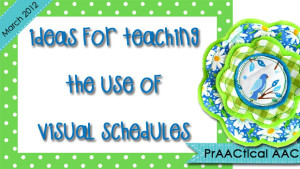
There’s nothing more depressing to us than walking into a classroom in the spring and seeing pristine visual schedules. Why? Because it probably means that the students aren’t really using them. We cheer when we see schedules that are rumpled and dog-eared, not shiny. Show me a battered and tattered visual schedule, and I’ll show you one that gets used every day. Sadly, that’s not always the case. – The bridge between having a visual schedule and consistently using it is one that many learners don’t seem to cross. Here are some of our ideas for helping your AAC learners to the other side. – 1. Have a plan to teach the schedule. If you are working one-on-one with a learner, you can easily implement the schedule and get them using it with most-to-least prompting. If you’re working with a group or a classroom, consider staggered implementation. Teaching 12 beginners... [Read More...]
Filed under: Strategy of the Month
Tagged With: intervention, visual schedule
March 17, 2012
by Carole Zangari -
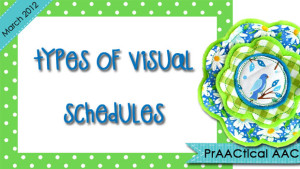
When people think about visual schedules, they tend to think about a classroom schedule with PCS for each major activity of the day. These are great and we look for them whenever we do classroom visits. In this post, we hope to inspire some of you to use other types of visual schedules as well. We haven’t quite worked out the right terms for these (and we welcome your suggestions) but, conceptually we know that there are three main levels of visual schedules. Each level conveys information about what is happening in a specific segment of time. – At the Calendar Level, the schedule represents what’s happening throughout the month and/or week. – At the Schedule Level, we’re representing the events of a particular day, a portion of a day, or a session (or class period). – At the Task Level, the schedule reflects discrete steps of an activity or... [Read More...]
Filed under: Strategy of the Month
Tagged With: intervention, visual schedule
March 10, 2012
by Carole Zangari -
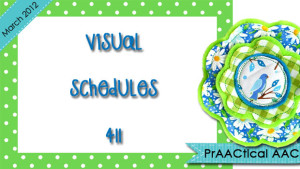
Visual schedules come in all shapes and sizes. The process of deciding which one to use begins with two questions: What is the purpose of this particular visual schedule? How will it be used? Both of these drive the decisions you make about which format to use. If my primary purpose in making the visual schedule is to help a student become more independent in following the steps in a task, and I know the person is going to be seated at a desk while doing this, I may choose a horizontal layout that shows the sequence. Because it is a school-aged child and we are activity working on literacy skills, I consider a stationary format on the desk surface that has the student use a check-off system. Having the student cross out or check off the steps as they are completed, gives authentic practice with writing skills. On the... [Read More...]
Filed under: Strategy of the Month
Tagged With: visual schedule
March 3, 2012
by Carole Zangari -

Here’s a riddle for you. Read the clues and guess what tool or strategy we’re talking about. Clue #1: It’s used in almost every classroom and therapy room serving students with ASD. Clue #2: The one for Johnny looks almost the same as the one for Jenny. Clue #3: It looks as nice in June as it did in September. If you guessed visual schedules, you’ve just named our March Strategy of the Month. Visual Schedules? But everybody already uses those. Why post about those? — Here’s why. – They’re ubiquitous. And yet when we talk with educators and SLPs about how the children are doing with their schedules, we get a look and a shrug. “Okay, I guess.” To be sure, okay is better than not okay. But visual schedules have so much potential to make lives better for clinicians, educators, and people with AAC needs that okay isn’t... [Read More...]
Filed under: Strategy of the Month
Tagged With: schedule, visual schedule
February 25, 2012
by Carole Zangari -
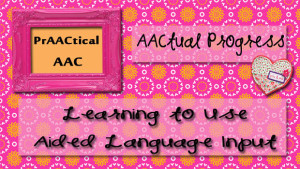
The only thing better than watching someone who uses AAC get the hang of it, is having the privilege of seeing this develop in future SLPs. Turn up the music, it’s time for the Happy Dance! I had the distinct pleasure this week of watching some of our graduate student clinicians ‘get it’ with respect to using the Strategy of the Month, Aided Language Input. It’s taken a few weeks, but then again they only see their AAC friends for a short amount of time. – Here are a few things we learned along the way. – 1. It takes time to get good at this. We’re speaking pidgin AAC until we get fluent, so just keep at it. Give yourself permission to be halting at first. Keep at it and the fluency will come. 2. It helps to start small. If the communication aid, SGD, or app is complex,... [Read More...]
Filed under: Strategy of the Month
Tagged With: aided language input, intervention
February 18, 2012
by Carole Zangari -
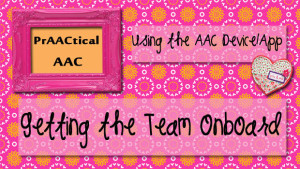
Families and professionals often share a common frustration when a new SGD, communication aid, or AAC app is introduced: Getting people to use it. Whether we’re fighting with insurance companies or navigating the educational maze, our attention is often consumed by getting access to the device. Then, oh happy day, it arrives. Round 1 is over. We won! We get it set up (no small feat). We start teaching the communicator to use it and everyone shares the excitement of this new tool. For awhile, anyway. – And then, reality sets in. – We realize that learning to communicate through this tool and building language skills with it is a p-r-o-c-e-s-s. There’s an arc to that process. It slowly sinks in that this new tool is necessary but not sufficient for real communication and language learning to occur. Though we knew that having the AAC device or app wasn’t going... [Read More...]
Filed under: Strategy of the Month
Tagged With: collaboration, implementation ideas, intervention
February 11, 2012
by Carole Zangari -
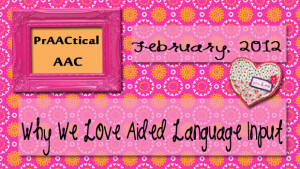
The concept of Aided Language Input is simple: Speak AAC to the learner. If you were teaching her French, you’d speak to her in French. No one would dispute that hearing the new language is an essential prerequisite to learning it. It’s the same in AAC. If we want our folks to learn to express themselves with AAC, they have to have a lot of expose to people speaking AAC. – Here are the top reasons we are such strong advocates of this as an intervention strategy. – 1. It has a strong research base, thanks to studies by Kathryn Drager, Cathy Binger and Janice Light, Jennifer Kent-Walsh, Shakila Dada, and others. – 2. It is the fastest way for a clinician, teacher, or parents to get familiar with the language in the AAC device. If we don’t know what words are in there and where they are located, can... [Read More...]
Filed under: Strategy of the Month
Tagged With: intervention, teaching strategy
February 5, 2012
by Carole Zangari -
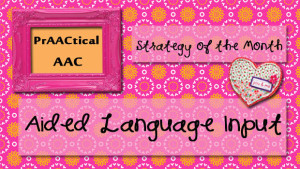
Aided language input is one of the first intervention strategies we teach our graduate student clinicians. Not only is it a great way to get familiar with the person’s AAC tools, but, more importantly, it provides are solid foundation for language learning. In future posts, we share more about the research base for this strategy and tips for implementation. For now, view this short screencast and get ready to speak AAC using aided language input.
Filed under: Strategy of the Month
Tagged With: aided language input, intervention
February 4, 2012
by Carole Zangari -
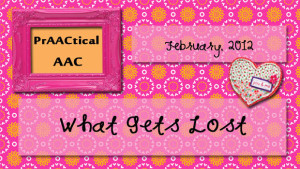
Imagine having one key communication strategy and no one knew that it existed. This horrifying experience was documented in the book ‘I Raise My Eyes to Say Yes,’ the autobiography of Ruth Sienkiewicz-Mercer. For years, she effectively used eye gaze with her family to answer yes/no questions, but when Ruth was placed at a residential facility, things eventually changed. Staff turnover, something we’re all familiar with, was the culprit. With time, new staff came in and didn’t realize that Ruth communicated with her eyes. Ruth was silenced for years until someone noticed that her ‘eyes up’ movement wasn’t reflexive or random. She was talking, but no one was listening. — While this was an extreme example, most AAC practitioners can recount their own stories of people whose AAC messages weren’t effectively translated once they moved to new settings. The transition to a new environment, where untrained partners may fail to recognize... [Read More...]
Filed under: PrAACtical Thinking, Strategy of the Month
Tagged With: AAC system, collaboration, Multimodal, visual literacy
January 20, 2012
by Carole Zangari -
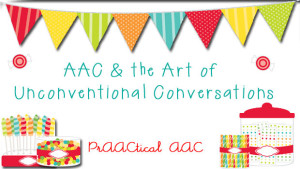
There’s an art to having a conversation with someone who has significant communication challenges. One of my favorite experiences with this dates back to the 1980’s, when I was working with a preschooler who had Rett Syndrome. Julia was a beautiful little girl who lived with her (very young) mom and her grandma. Grandma watched Julia while mom was in school, and I spent a good amount of time visiting them in their modest home (a trailer) trying to earn their trust and figure out how to help Julia communicate better in school. – At home, as it turns out, she was communicating just fine, at least for the very basic things. A typical conversation between Julia and her grandma went like this. Julia paces around the coffee table, wringing her hands, rocking a bit, and staring at the carpet. She pauses in front of the TV and Grandma says... [Read More...]
Filed under: PrAACtical Thinking, Strategy of the Month
Tagged With: communicative acts, Conversations, Multimodal









